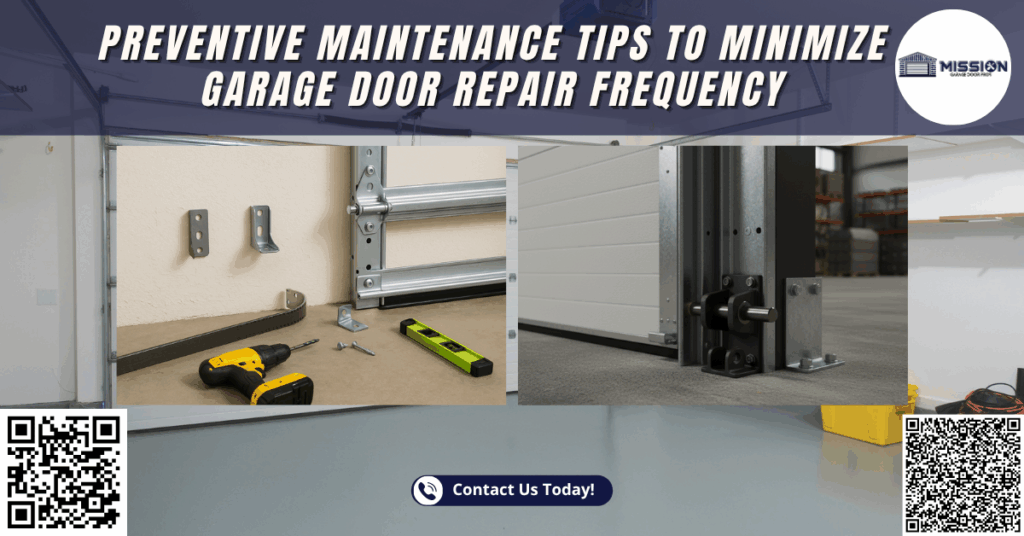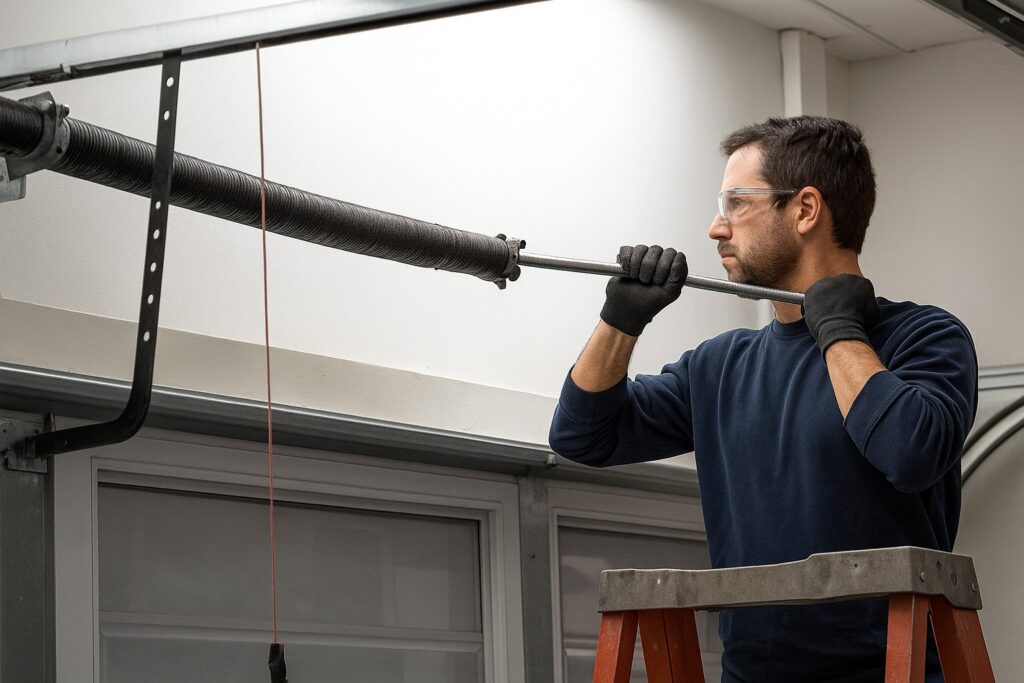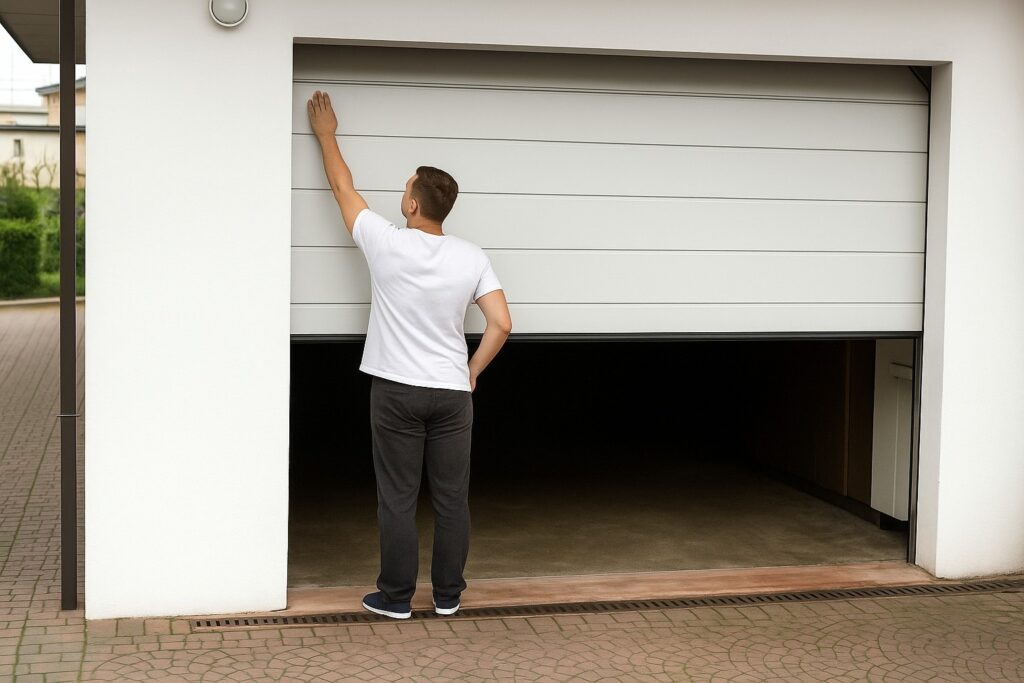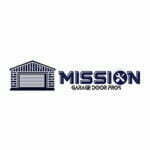
Unexpected garage door repair can ruin your day. Picture this. You arrive home in Mission, TX after a long shift, press the remote, and the door shudders, tilts, and stops. We handled a very similar case for a family near 2301 N Shary Rd. The opener strained because the springs had weakened, the rollers were dry, and the tracks were slightly out of alignment. The fix required springs, a few parts, and careful adjustments. The homeowner later told us that a little routine care would have prevented the breakdown and the stress. That is the power of preventive maintenance. It turns surprise repairs into simple, planned service.
Here is another situation we see often. A small business with a busy loading area keeps the door moving many times a day. The manager called because the door dragged on one side and the opener made a grinding sound. Our technicians found worn rollers, loose track brackets, and a dry center bearing. We performed a thorough inspection, a full lube and tune, tightened hardware, and reset the opener force. The door returned to quiet, smooth operation. A short monthly checklist would have caught these problems early and kept the operation on schedule.
If you remember one message from this guide, let it be this. A garage door is a system. The springs lift. The tracks guide. The rollers carry. The opener leads. The sensors protect. The panels shield. Each part affects the others. Preventive maintenance keeps the whole team working together with precision. It extends service life, reduces repair frequency, and increases safety for your home or business.
Why Preventive Maintenance Matters More Than You Think
Every open and close is a cycle. Most residential springs are rated for many thousands of cycles, yet dust, humidity, temperature swings, and lack of lubrication reduce that number. Skipping care leads to worn rollers, stretched cables, loose hinges, and stressed openers. The result is noise, vibration, and eventually a breakdown.
Preventive maintenance is simple. Clean, inspect, lubricate, tighten, and test. These steps protect your investment, keep your door quiet, and help you avoid emergency calls. For commercial doors that serve a business, regular maintenance also improves safety, protects schedules, and lowers long term costs compared to repeated repairs.
At Mission Garage Door Pros, we recommend a biannual tune up for most homes and a quarterly plan for busy locations. More frequent service may be wise if your door is the main entry for the family or the main gate for deliveries.
The Three Healthy Habits That Save You From Most Repairs
Look. Listen. Lightly test.
Set aside five minutes each month.
- Look at the panels, hinges, rollers, tracks, cables, spring cones, and brackets. Search for rust, frayed strands, bent metal, and missing fasteners.
- Listen during a full open and close. Healthy doors sound smooth. Harsh scraping, banging, squealing, or rattling hints at misalignment or dry parts.
- Lightly test by lifting the door a few inches and letting it rest. If it feels very heavy or will not stay where you place it, the balance is off and a professional should check the springs.
Small signs reveal big problems early. Early attention makes repairs faster and less expensive.
Safety First: What Homeowners Should and Should Not Do
There are safe tasks for any homeowner and there are high tension tasks that only trained technicians should handle.
Safe for homeowners
- Cleaning the tracks with a dry cloth.
- Wiping panels and weather seals.
- Lubricating hinges, rollers, and bearings using a garage door rated lubricant.
- Tightening obvious loose screws on hinges and struts.
- Replacing remote batteries.
- Testing photo eye sensors and the auto-reverse function.
Leave to professionals
- Adjusting torsion or extension springs.
- Replacing cables or cable drums.
- Replacing center bearings or end bearings.
- Realigning bent tracks.
- Setting opener force limits when the door balance is unknown.
- Any repair on a broken garage door that is stuck mid travel.

Your safety matters. Springs and cables store energy. The right tools and training prevent injury and prevent secondary damage to the door system.
Tools and Supplies For Smart Home Maintenance
- Soft cloths and a mild detergent for panels.
- Dry cloths and a small brush for track cleaning.
- Non-silicone cleaner for photo eyes.
- Garage door rated lithium or silicone spray lubricant.
- A small socket set and screwdriver set for hinge screws.
- Fresh remote and keypad batteries.
- A step stool for safe, stable access.
Keep these in a small bin on a shelf. When the supplies are easy to reach, maintenance actually gets done.
Monthly Homeowner Checklist
Follow this quick list once per month. It works for single doors, double doors, and insulated doors.
- Visual scan. Start inside the garage with the door closed. Look at springs, cables, brackets, and hinges. Look for rust, strands, or cracks.
- Track cleanliness. Wipe the inside of the vertical and horizontal tracks to remove dust. Do not lubricate the tracks.
- Roller check. Rollers should be round and centered. If you see flat spots or cracked nylon, schedule a replacement.
- Hardware check. Tighten hinge screws and light hardware. If a bracket is loose at the wall or header, call a technician for a secure reset.
- Lubrication. Lightly lube hinge pins, roller bearings, and the spring coils. Wipe away excess.
- Photo eye test. Close the door and wave a broom in front of the sensors. The door should reverse immediately. Clean the lenses if needed.
- Balance sense. With the opener disconnected, lift the door by hand to mid height. It should stay in place. If it drifts, the springs need professional adjustment.
- Remote and keypad. Press each button. Replace batteries if response is slow.
Ten minutes a month prevents hours of hassle later.
Seasonal Care in Mission, TX: Heat, Wind, Dust, and Storms
Our area sees intense heat, dust, and storm bursts. Seasonal habits keep your door ready.
Spring
- Lube all moving parts before the heat arrives.
- Check the bottom seal for cracks from winter hardening.
- Clean the photo eyes after windy days.
Summer
- Inspect paint or protective finish on steel or wood panels.
- Check opener settings. Heat can change how the opener senses resistance.
- Ensure attic vents and garage airflow are open to reduce heat buildup around the motor.
Fall
- Clean debris from tracks after dusty months.
- Confirm weather seals fit tight to keep out cool drafts and pests.
- Book your biannual tune up with our team before the holiday rush.
Winter
- Keep the bottom threshold clear to prevent the seal from freezing to the concrete after a cold rain.
- Replace weak remote batteries since cold lowers battery output.
- Perform a quick test of the auto-reverse feature after the first cold snap.
Deep Dive: Lubrication That Actually Works
Use a garage door specific lithium or silicone spray. Apply a light, even coat to these points:
- Hinges where the knuckle rotates.
- Roller bearings at the axle inside the roller.
- Torsion springs along the coils. Light lube reduces metal friction and helps prevent corrosion.
- Lock mechanisms so the key and slide move smoothly.
- End bearings on the shaft above the door.
Do not spray the tracks. Lubed tracks attract dust and can cause the rollers to slide rather than roll. Wipe up drips to protect flooring and keep the garage neat.
Hardware Tightening and Why It Matters
Vibration loosens fasteners. If a hinge shifts, the door sections may twist, causing premature wear on rollers and the opener. During your monthly check, tighten the hinge screws that connect to the door panels and the strut screws that support wide doors. If you notice a lagging bracket at the wall or a cracked support, stop and call a professional. Re-securing structural supports takes proper anchors and an understanding of load paths.
Track Alignment and Clean Movement
Tracks must be plumb, level, and parallel. If the door scrapes or rubs, something is off. Homeowners can safely verify that the tracks are firmly anchored, clean, and free of dents. If you see a bend, a gap between the rollers and the track lips, or a track that twists, let a trained technician realign it. We set precise spacing and torque on every bracket to ensure quiet, even travel.
Balance and Springs: How We Test and Set Them
Balance keeps the door from feeling heavy and keeps the opener from working too hard. Our technicians disconnect the opener, lift the door to different heights, and confirm that it stays where placed. If not, we measure the spring wire size, diameter, and length, then set proper torque for your specific door weight. Correct balance extends opener life, protects gears, and gives you a smooth manual lift during power outages.
Opener Health: Chain or Belt Tension, Force Limits, and Sensors
Your garage door opener is the leader of the system. We check three things during every maintenance visit.
- Drive tension. Chains and belts should not droop or sing tight. Proper tension keeps movement smooth without overloading bearings.
- Force limits and travel limits. These settings tell the opener when to stop and how much resistance is allowed before reversal. Correct settings are a safety essential.
- Photo eyes and wall controls. Clean lenses, secure wiring, and stable mounts prevent nuisance stops and keep your family safe.
If your opener is more than a decade old, a modern unit with a quiet DC motor, soft start and stop, bright LED lighting, battery backup, and smart controls may reduce future service needs while adding convenience.
Weather Seals and Thresholds: Comfort and Protection
Weather seals do more than block drafts. They keep dust, leaves, and insects outside, protect stored items, and reduce energy loss. Inspect three areas.
- Bottom seal. A fresh bottom seal creates a soft, even contact with the floor. If it is cracked or stiff, replace it.
- Jamb seals on the sides and top. These flexible vinyl strips press lightly on the door face to close side gaps. If they curl or detach, renew them.
- Threshold seal. In driveways that slope or in garages where water tracks inside, a threshold strip bonded to the floor can lift the seal line and keep water outside.
Ask our team to recommend the best material for Mission’s climate. Vinyl and rubber each have strengths. We size and install for a true, tight seal.
When To Replace Rollers and Hinges
Rollers and hinges bear motion every cycle. Nylon rollers are quiet and smooth. Steel rollers can last longer with regular care. Replace rollers if they wobble on the axle, show flat spots, or make grinding sounds. Replace hinges if the knuckle wears thin or cracks appear near the screw holes. Fresh rollers and hinges are one of the fastest ways to quiet a noisy door and reduce opener strain.
Cleaning and Finishes: Protecting Panels for Years
Keep panels clean using mild soap and water. Rinse well and dry. For steel doors, inspect for nicks and touch up paint to prevent rust. For wood doors, check finish yearly. A clean door is not only attractive. It also shows problems early, such as hairline cracks, loose trim, or swelling around window frames.
Annual Professional Inspection: What Our Tune Up Includes
Our annual inspection is a full system evaluation and service. Here is what we include.
- Measure spring balance and cycle the door by hand.
- Inspect torsion or extension springs, cables, and end bearings.
- Check tracks for alignment, spacing, and fastener torque.
- Inspect rollers and hinges and recommend replacements when needed.
- Test opener force, travel, and safety reversal.
- Clean photo eyes and confirm alignment.
- Lube all moving parts properly.
- Inspect weather seals and the bottom threshold.
- Review panel integrity, struts, and reinforcement brackets.
- Provide a simple status report and a plan for the next service.
This thorough inspection helps you plan, avoid surprises, and keep your door in top condition.
Troubleshooting Quick Guide: Common Symptoms and Simple First Steps
- Door will not close and the lights on the opener blink – Clean the photo eyes and make sure both sensor lights are steady. Clear any boxes from the doorway.
- Door starts to close, then reverses – Check for debris on the tracks or tight spots, then call for a balance and force check.
- Door is loud and rattles – Lube rollers and hinges, tighten hinge screws, and schedule a professional track and roller check.
- Remote works only up close – Replace the battery and check for interference from new electronics near the opener.
- Door feels heavy when lifted by hand – Stop and call a professional. Springs likely need adjustment or service.

If the door is crooked, stuck half open, or the cable has jumped the drum, do not try to force it. Secure the area and contact our team.
Business and Commercial Doors: Extra Tips for High Cycle Operations
If you operate a commercial garage door or a gate at a business, you need a plan that fits your schedule and cycle count.
- Log daily open and close counts to estimate cycle use.
- Lubricate monthly and schedule pro inspections quarterly.
- Keep a clean zone around the tracks and the door path for safety.
- Train staff to report noise or hesitation right away.
- Post emergency numbers near the wall control and keypad.
These habits protect people and products and keep your workflow on time.
When An Upgrade Makes Sense
There comes a time when an older system needs more than repair and maintenance. Consider an upgrade if the door sags, panels are rusted, the opener is loud and unreliable, or you have repeated failures. New garage doors improve safety, insulation, and curb appeal. New openers provide smartphone control, strong LED lighting, and battery backup for storms. A modern system lowers the need for service and gives you years of reliable operation.
Record Keeping: Your Maintenance Log
Keep a simple list with dates, tasks, and notes. Include lubrication, small fixes, replacements, and professional visits. A log helps you see patterns, plan budgets, and share helpful details with technicians. It also supports better warranty service for openers and parts.
Clear, Actionable Maintenance Calendar
Every month
- Visual scan of springs, cables, rollers, and hinges
- Track wipe down
- Photo eye cleaning and test
- Remote battery check as needed
Every six months
- Full lubrication of moving parts
- Tightening of hinge screws and light hardware
- Opener test for force and travel
Every year
- Professional tune up and safety inspection
- Weather seal review and replacement if required
As needed
- Roller or hinge replacement
- Bottom seal and side seal renewal
- Opener upgrade or repair
Consistency beats intensity. A small habit each month protects your door for years.
Frequently Asked Questions (FAQs)
Q1: How long can I expect my garage door springs to last before they need replacement?
Most torsion or extension springs are rated for around 10,000 cycles (one open + close = one cycle). If you use the door frequently (for example a business or busy household), the springs may wear out sooner and should be monitored every year.
Q2: Are smart garage door openers more reliable and worth the extra cost?
Yes, in many cases smart openers offer improved safety features (such as smartphone alerts and battery backup), quieter operation, and remote monitoring. They still need the same mechanical maintenance, so you’ll save on convenience but still follow good preventive care.
Q3: Can extreme weather like heavy heat, storms or dust reduce the lifespan of my garage door system portions?
Absolutely — high heat, gusty winds, dust infiltration and humidity can accelerate wear on rollers, springs, seals and openers. If your door is exposed to tough conditions (like in Mission, TX) you should increase inspection frequency and maybe invest in heavier-duty parts.
Q4: Will upgrading to an insulated garage door panels or stronger springs reduce my maintenance needs?
Upgrading can help — insulated panels can reduce warping or weather-related damage, and properly sized springs reduce strain on the opener. But even upgraded doors still require regular tightening, lubrication and inspections to keep maintenance frequency down.
Final Thoughts: A Simple Plan That Prevents Most Problems
Preventive maintenance is a promise you make to your home or business. A clean track, a small squirt of lubricant, a tightened screw, and a quick sensor test keep your door safe, quiet, and reliable. Most breakdowns happen after long periods without care. A monthly habit and a trusted local partner change that story.
If you follow the checklists in this guide, you will reduce the frequency of garage door repair, improve the life of your opener and springs, and enjoy smooth operation every day.
How Can Mission Garage Door Pros Help You?
Our team at Mission Garage Door Pros is ready to support your home or business with expert inspections, honest recommendations, and quality workmanship. We keep your system in top condition with maintenance plans designed for how you use your door.
What we do for you
- Detailed safety and performance inspections
- Precision balance and spring service
- Quiet roller and hinge upgrades
- Track cleaning and alignment
- Photo eye testing and opener tuning
- Weather seal replacement for comfort and protection
- New garage door and opener installation when it is time for an upgrade
- Friendly answers to your questions and help scheduling an appointment that fits your time
Local. Reliable. Ready today.
📍 Address: 2301 N Shary Rd, Mission, TX 78674, United States
📞 Phone: (956) 997-9215
Contact Mission Garage Door Pros today to schedule your preventive maintenance visit. Tell us about your door’s condition, the sounds you hear, and any issues you want solved. Our expert team will arrive on time, provide a thorough inspection, and complete the job with the quality and precision you expect. Your door will run smoothly, your home will be safer, and your day will be easier.
- Preventive Maintenance Tips to Minimize Garage Door Repair Frequency
- Mission, TX Automatic Garage Doors: Common Features and Benefits
- Mission, TX Garage Door Opener Repair: Solutions for Common Issues
- Mission, TX Garage Door Tune-Up: Common Tasks and Benefits
- Garage Door Maintenance in Mission, TX: Keep Your Garage Doors Safe and Secure
